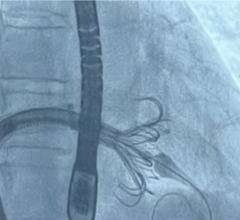April 21, 2008 - The first patients were treated in a U.S. feasibility study using the Edwards Lifesciences SAPIEN transcatheter heart valve in addressing a congenital condition in which the valve between the right ventricle and the pulmonary artery is nonfunctional.
"We were able to successfully implant the Edwards SAPIEN transcatheter heart valve percutaneously in the first three patients treated in this trial. All of the patients are recovering and are expected to go home today," said Ziyad M. Hijazi, M.D., M.P.H., director of the Rush Center for Congenital and Structural Heart Disease, chief of the section of pediatric cardiology and professor in the departments of pediatrics and internal medicine at Rush University, Chicago, and a paid consultant to Edwards Lifesciences. "Patients with congenital right ventricular outflow tract problems typically face the burden of multiple open-heart surgeries throughout their lives, either to replace their 'native' diseased valves or, as they age, their bioprosthetic replacement valves. This clinical study will enable physicians to offer a minimally-invasive alternative to symptomatic patients with a failing pulmonary valve conduit, giving them the opportunity to recover and resume their normal activities."
The FDA conditionally approved the investigational device exemption (IDE) clinical trial in late 2007. The study of 30 patients at three hospitals will enable the collection of safety and effectiveness data, ultimately in support of a commercial approval application.
In this transcatheter valve replacement procedure, the Edwards SAPIEN bovine pericardial valve is compressed onto a balloon to the approximate diameter of a pencil, threaded through the patient's circulatory system from the leg using the RetroFlex transfemoral delivery system and deployed across the patient's pulmonary valve. The valve replacement is accomplished as a "beating heart" procedure, without requiring cardiopulmonary bypass or an open-chest incision.
The Edwards SAPIEN transcatheter heart valve is also currently being studied in the PARTNER (Placement of AoRTic traNscathetER valves) U.S. pivotal trial for the treatment of patients with severe aortic heart valve stenosis (a narrowing of the aortic valve that restricts blood flow), who are considered to be high risk for conventional open-heart valve replacement surgery.
For more information: www.edwards.com


 April 29, 2025
April 29, 2025 








